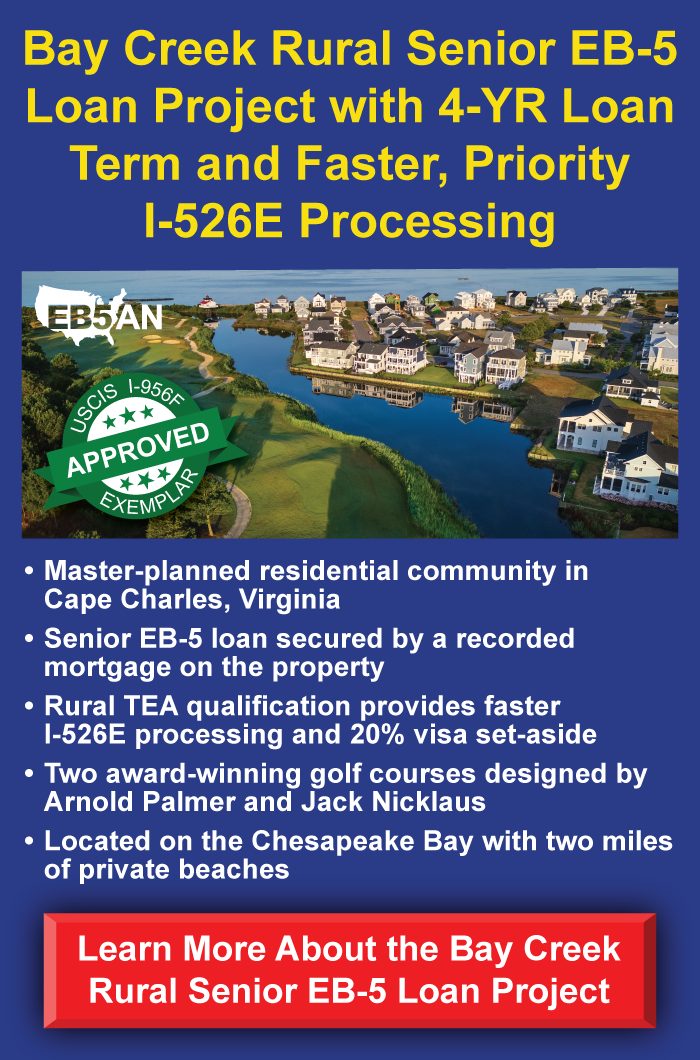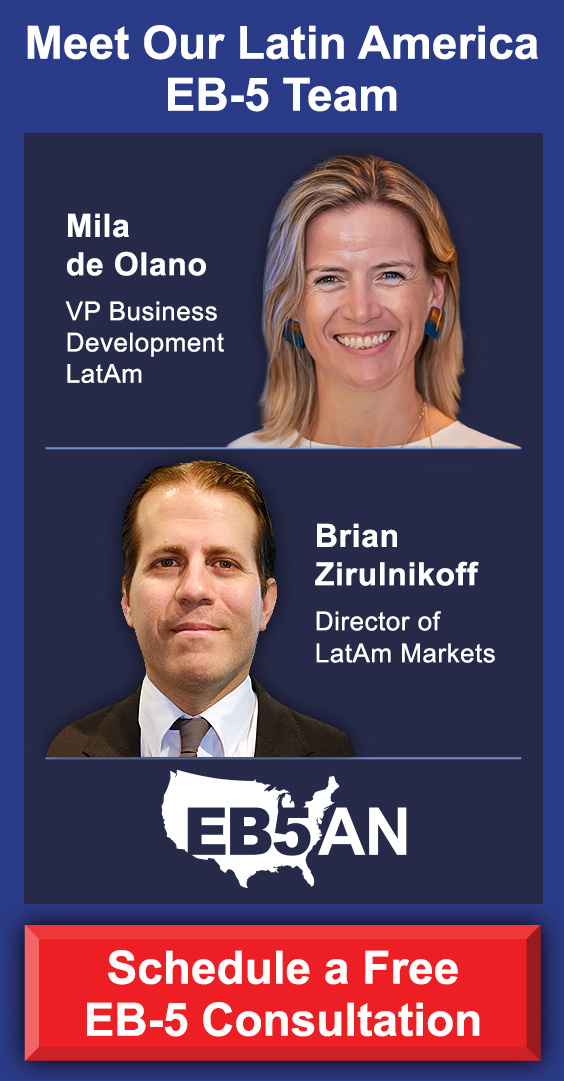In March 2024, Invest in the USA (IIUSA) initiated a lawsuit against U.S. Citizenship and Immigration Services (USCIS) in response to revisions made to the long-standing two-year sustainment period requirement for EB-5 investments. On February 27, 2025, a Joint Status Report (JSR) was filed in federal court by IIUSA and USCIS, outlining potential resolutions to the dispute. The JSR could significantly affect current and future EB-5 investors. This article provides an overview of the policy change, the lawsuit, the latest updates, and offers insights into the potential impact on investors.
Background: The October 2023 Two-Year Sustainment Period Policy Change
The IIUSA Lawsuit Against USCIS
The Joint Status Report Filed on February 27, 2025
EB5AN’s Current EB-5 Offerings with a Short Investment Period
- ONE Tampa (Loan) – Urban TEA project with I-956F Approval
- Boynton Beach Multifamily (Equity) – Urban TEA project with I-956F Approval
EB5AN Is Committed to Helping EB-5 Investors Make Informed Choices
Watch Full Webinar
Watch Webinar Highlights
IIUSA Lawsuit and Sustainment Period Guidance
Background: The October 2023 Two-Year Sustainment Period Policy Change
In October 2023, USCIS announced a policy update intended to align with the EB-5 Reform and Integrity Act of 2022 (RIA). Previously, the two-year at-risk requirement for EB-5 investments was generally understood to begin when an investor’s conditional permanent residency was granted. Under the October 2023 update, however, USCIS indicated that the two-year clock for the investment period would start when the investor’s funds were first invested—effectively altering the long-standing interpretation tied to conditional resident status.
Shortly afterward, IIUSA filed a lawsuit challenging the new policy, arguing that it was introduced without following proper rulemaking procedures and without adequately considering EB-5 stakeholders.
The IIUSA Lawsuit Against USCIS
IIUSA, a nonprofit EB-5 industry trade organization, sued USCIS in March 2024 over the revised sustainment period policy. The primary claims were:
- Improper Procedure: The policy was announced via guidance rather than through the formal notice-and-comment rulemaking process.
- Lack of Stakeholder Consideration: Stakeholders in the EB-5 industry, particularly investors, were not given sufficient opportunity to provide feedback on the new policy.
The lawsuit highlighted issues that had already caused significant confusion in the industry. Any uncertainty related to program requirements can undermine trust and complicate investment decisions.
The Joint Status Report Filed on February 27, 2025
In the Joint Status Report filed in federal court on February 27, 2025, IIUSA and USCIS provided updates on their respective positions, including a proposal by IIUSA that could have significant impacts on both current and future EB-5 investors.
IIUSA’s Proposal
IIUSA indicated that it prefers a sustainment period defined by a fixed number of years, established through formal rulemaking, rather than one tied to the duration of an investor’s conditional residency. Specifically, IIUSA proposes:
- Grandfathering for RIA ($800K) Investors Who Invest BEFORE a Forthcoming Settlement Between IIUSA and USCIS: EB-5 investors who invested prior to a future settlement agreement would be allowed to benefit from the October 2023 policy, which makes the minimum investment sustainment period a fixed two years. A settlement agreement may be reached any time after February 27, 2025, but most likely within the next 30 days, before the end of March, 2025.
- Possible Different Investment Requirement for Future RIA ($800K) Investors Who Invest AFTER a Forthcoming Settlement Between IIUSA and USCIS: Investors who invest after a future settlement agreement would be subject to a new, fixed minimum investment sustainment period (longer than two years). This new rule would likely be determined through a formal notice-and-comment process. Notably, this longer minimum investment sustainment period would likely not be linked to the time it takes for EB-5 investors to obtain or hold a temporary Green Card.
IIUSA reiterated in the JSR that it does not seek a return to the original sustainment period tied to each investor’s temporary Greem Card, citing the burdens such a requirement places on investors.
The JSR proposes that both parties file another status report within 14-30 days. Until Judge Reyes issues a ruling or a settlement is reached, the outcome remains uncertain.
What This Update Means for EB-5 Investors
While no definitive timeline or outcome can be guaranteed, several possibilities emerge from the JSR:
- Sustainment Period Defined Through Rulemaking: USCIS may initiate formal rulemaking to establish a new investment period. It is possible that the new period sets a clear, fixed sustainment period, in keeping with IIUSA’s preference. This would likely provide more certainty for new investors once finalized
- Grandfathering for Current Investors: Investors who invest before a settlement is reached may be grandfathered under the October 2023 interpretation—meaning their investment would be subject to only a two-year minimum sustainment period.
- Longer Sustainment Period for Future Investors: Any future investment period determined after a settlement agreement could be longer than two years (for example, five years) to ensure compliance with the RIA, subject to the formal rulemaking process.
How Savvy Investors Are Likely to Respond
Given the uncertainty but potential for grandfathering benefits, many well-informed EB-5 investors may choose to invest before the forthcoming lawsuit settlement to secure the shorter, two-year sustainment period. Once the settlement agreement is in place, new investors could face an unknown, longer sustainment period requirement.
EB5AN’s Current EB-5 Offerings with a Short Investment Period
For investors looking to take advantage of a shorter investment term, EB5AN offers EB-5 projects with target investment durations of three to four years:
ONE Tampa (Loan) – Urban TEA project with I-956F Approval
ONE Tampa is a 42-story, luxury condominium tower in downtown Tampa, Florida.
Key Project Highlights:
- The EB-5 loan has a repayment guaranty from a diversified Kolter parent company.
- The project offers a shorter 3-year loan term, reducing duration of funds at risk.
- The project’s I-956F exemplar application has been approved by USCIS.
- Strong sales to date with 104 of 225 total condo units (46%) already presold.
- The project enjoys a substantial job surplus with 381 jobs created as of December 31, 2024, and 2,966 total jobs at completion; only 1,000 jobs are needed for 100 EB-5 investors.
Boynton Beach Multifamily (Equity) – Urban TEA project with I-956F Approval
Boynton Beach Multifamily is a 210-unit apartment complex for active adults (55+) in Boynton Beach, Florida.
Key Project Highlights:
- The project offers a 5.0% annual preferred return.
- The target investment duration is only 3.75 years.
- The I-956F exemplar application has been approved by USCIS.
- The project has limited competition since no active adult apartment communities exist or are planned within a 5-mile radius of the project.
- The project capitalizes on the area’s demographic makeup, which is largely older and affluent—Florida is, after all, the #1 U.S. state for retirement.
EB5AN Is Committed to Helping EB-5 Investors Make Informed Choices
At EB5AN, we understand that making an EB-5 investment is a significant decision. We strive to offer clarity, transparency, and timely updates on evolving industry regulations and legal challenges. As the IIUSA lawsuit progresses and any new policies are introduced, we will continue to provide insights and guidance.
If you have questions or would like to explore EB-5 investment opportunities, we invite you to schedule a free consultation with us. Our team is here to help you navigate the EB-5 landscape and make informed decisions that align with your immigration and financial goals.







